M-class: Difference between revisions
Pbcjohnston (talk | contribs) mNo edit summary |
Pbcjohnston (talk | contribs) mNo edit summary |
||
| (15 intermediate revisions by 2 users not shown) | |||
| Line 1: | Line 1: | ||
[[File:M-Boat Header 1.jpg]] | [[File:M-Boat Header 1.jpg]] | ||
=== <big>Design, Construction, and Naming Notes</big> === | === <big>Design, Construction, and Naming Notes</big> === | ||
<div style="text-align: justify;"><span style="color:#00008B"> | <div style="text-align: justify;"><span style="color:#00008B">M-1 was a unique submarine, the only one of its class. All submarines up to this point, either Lake or EB designs, had been single hull boats, with all of the ballast tanks and fuel tanks internal to the pressure hull. In a double hull boat, the inner pressure hull was fully wrapped by an outer hull, and the space between the hulls was used for ballast and fuel tanks. The goal was to gain a lot of internal space that could be used for weapons, more powerful engines, and a larger crew. This design by Electric Boat was breaking new ground, as the only other double hull boat in USN service was the Italian Laurenti designed [[G-4|'''G-4 (SS-26)''']]. Because of the lack of experience in building this hull type, the results were not good. The tankage space was very tight and difficult to maintain, and the complicated venting and flooding arrangement made her very unstable when surfacing. She often took large lists until the tanks were fully emptied. M-1 had a short service life, only four years. No further double hulled boats were built for the USN until the [[T-class|'''T-class''']] fleet submarines of 1920-1922. They were based on an expanded M-class hull and were equally unsuccessful. Double hull and partial double hull submarines were the way of the future, but advances in metallurgy and more experience in building this hull type was needed before it could be successful.</span> | ||
[[File:Red bar sub new.jpg]] | [[File:Red bar sub new.jpg]] | ||
=== <big> | === <big>M-1 (Submarine No. 47, later SS-47)</big> === | ||
[[File:M-1 | [[File:Ussm-1q.jpg|left|500px]] | ||
<div style="text-align: justify;"><span style="color:#00008B"> | <div style="text-align: justify;"><span style="color:#00008B">M-1 on the building ways at Fore River Shipbuilding, Quincy MA., October 1, 1914. The framework that surrounded her inner hull can be seen in the center, with the skeleton frames of her bow on the left. The circular frames are what the outer hull plating would be attached to at a later date. Her launching date was still 11 months in the future. | ||
<small>Photo courtesy of the Submarine Force Library & Museum.</small> | |||
[[File:Red bar sub new.jpg]] | |||
[[File:Ussm-1r.jpg|left|500px]] | |||
<div style="text-align: justify;"><span style="color:#00008B">This photo was taken on the same day as the one above, October 1, 1914. Details of M-1's frames can be seen. This view is from the bow looking aft. | |||
<small>Photo courtesy of the Submarine Force Library & Museum.</small> | |||
[[File:Red bar sub new.jpg]] | |||
[[File:Ussm-1build.jpg|left|500px]] | |||
<div style="text-align: justify;"><span style="color:#00008B">M-1 later in her construction phase, April 9, 1915. This view is from the bow looking aft. The mushroom shaped structure in the middle is the upper part of the tub for the retracting 3"/23 caliber Mk 9 gun that she would be later fitted with. The gun would retract vertically into this watertight tub, leaving only the end of the barrel above deck. The intention was to reduce underwater drag. | |||
<small>Photo courtesy of the Submarine Force Library & Museum.</small> | |||
[[File:Red bar sub new.jpg]] | |||
[[File:M-1_launch_Aug_1917.jpg|left|500px]] | |||
<div style="text-align: justify;"><span style="color:#00008B">M-1 on her launch day, September 14, 1915, Fore River Shipbuilding, Quincy MA. Both of the shutter doors for her port side torpedo tubes can be seen. At the tip of the bow is the squared-off towing fairlead (aka "bullnose"), and her bow planes are folded up alongside the superstructure. The men on deck are all Fore River and EB employees. | |||
<small>Photo courtesy of the Submarine Force Library & Museum.</small> | |||
[[File:Red bar sub new.jpg]] | |||
[[File:Ussm-1u.jpg|left|500px]] | |||
<div style="text-align: justify;"><span style="color:#00008B">M-1 afloat at last in Mill Cove off Quincy Bay, MA., September 14, 1915. She still has stern way on, but drag chains attached to the building slip will be quickly arresting her motion. A tug will tie up and move her to the fitting out pier to finish her construction. She was roughly 60% complete at this point. | |||
<small>Photo courtesy of the Submarine Force Library & Museum.</small> | |||
[[File:Red bar sub new.jpg]] | [[File:Red bar sub new.jpg]] | ||
[[File:M-1 news paper.jpg|left|500px]] | |||
<div style="text-align: justify;"><span style="color:#00008B">M-1 is shown here on builder's trials, probably in Long Island Sound, early 1917. Outwardly she looked a lot like a bigger L-class boat, but she had a radically different hull type. She tended to be a wet boat on the surface, and she became dangerously unstable during the surfacing process. | |||
<small>National Archives Photo</small> | |||
[[File:Red bar sub new.jpg]] | |||
[[File:M-1 officers quarters.jpg|left|500px]] | |||
The M-1's officer quarters, in a small compartment between the torpedo room and the crew's quarters. This view is looking aft. The bunk on the right is lifted up exposing a storage locker underneath. A Pullman-style fold up sink is on the bulkhead. The door leads to the battery compartment. | |||
<small>Photo courtesy of the Submarine Force Library & Museum.</small> | |||
[[File:Red bar sub new.jpg]] | |||
[[File:M-1 interior battery compartment.jpg|left|500px]] | |||
The battery compartment looking forward. The boat's 120 cell battery is located below this deck. Above the deck is the crew's berthing area. The bunks are all triced up to the overhead. Storage lockers are along both sides. | |||
<small>Photo courtesy of the Submarine Force Library & Museum.</small> | |||
[[File:Red bar sub new.jpg]] | |||
[[File:M-1 battery compartment.jpg|left|500px]] | |||
The battery compartment looking aft. The large tub hanging down from the overhead is the tub for the retracted 3"/23 caliber gun. Meters for monitoring the electrical charge in the battery are on the aft bulkhead. The door on the left leads to the control room. | |||
<small>Photo courtesy of the Submarine Force Library & Museum.</small> | |||
[[File:Red bar sub new.jpg]] | |||
[[File:M-1 port control room.jpg|left|500px]] | |||
The control room of M-1, looking forward and to port. The wheel on the forward bulkhead is the helm. The large handles are for when it has to be put into hand power mode. The bow and stern diving planes wheels are on the left with the depth gauges in between. Air manifolds for ballast control are between the helm and the bow planes wheel. The eyepiece for the periscope is in the overhead. The periscope did not retract. | |||
<small>Photo courtesy of the Submarine Force Library & Museum.</small> | |||
[[File:Red bar sub new.jpg]] | |||
[[File:M-1 control room.jpg|left|500px]] | |||
The M-1 control room looking forward and to starboard. In the left center is the trim pump used for pumping ballast water to various tanks, along with the valve manifold for the trim system. To the right are the levers for the Kingston valves that close off the bottom of the ballast tanks. The door next to the helm goes forward into the battery compartment. | |||
<small>Photo courtesy of the Submarine Force Library & Museum.</small> | |||
[[File:Red bar sub new.jpg]] | |||
[[File:M-1 control room aft.jpg|left|500px]] | |||
This is the control room looking aft. The periscope eyepiece is in the foreground in the overhead. On the right is the scullery for dishes, followed by the galley equipment. Against the back bulkhead are electrical controls for controlling speed. The watertight door leads to the engine room. To the left of the door on the starboard side are electrical controls and knife switches for lining up the battery for charging or operation. | |||
<small>Photo courtesy of the Submarine Force Library & Museum.</small> | |||
[[File:Red bar sub new.jpg]] | |||
[[File:M-1 engine room looking aft.jpg|left|500px]] | |||
Stepping through the aft door in the control room you would be presented with this sight. This is the engine room looking aft. These two engines are NELSECO 70/6MS diesels. Directly above is an access hatch to the main deck topside. The two large pipes at the top of each engine is the air intake piping for the engines. The door in the background leads to the motor room. | |||
<small>Photo courtesy of the Submarine Force Library & Museum.</small> | |||
[[File:Red bar sub new.jpg]] | |||
[[File:M-1 engine room.jpg|left|500px]] | |||
This is the engine room looking forward from the aft end. The valve rocker arms for each engine are exposed along the passage way. An inattentive move by a Motor Machinist Mate could result in a nasty injury from one of the constantly moving rocker arms. | |||
<small>Photo courtesy of the Submarine Force Library & Museum.</small> | |||
[[File:Red bar sub new.jpg]] | |||
[[File:M-1 engine room port aft.jpg|left|500px]] | |||
The last compartment is the motor room. This compartment has two very large Electro Dynamic propulsion motors that drive the sub when it is submerged, using electricity from the batteries. The motors double as generators when the engines are running. In that mode they are used to recharge the batteries. | |||
<small>Photo courtesy of the Submarine Force Library & Museum.</small> | |||
[[File:Red bar sub new.jpg]] | |||
[[File:M-1 motor room looking forward.jpg|left|500px]] | |||
This is as far aft as you can go in the M-1. This view is in the motor room looking forward. There is an access ladder and hatch leading to the main deck. The door in the background leads back into the engine room. Both of the main motors can be seen here. The open casings were needed to keep them cool, but they presented a liability if even a small amount of moisture got into them. | |||
<small>Photo courtesy of the Submarine Force Library & Museum.</small> | |||
[[File:Red bar sub new.jpg]] | |||
[[File:M-1 deck gun.jpg|left|500px]] | |||
This view is topside and shows the 3"/23 caliber Mk 9 gun in the raised position. The round shield doubled as the top of the watertight tub when the gun was retracted. As you can see, there was little room on deck to operate the gun. There seems to be a mix of Navy and civilian men on deck, indicating that this photo was taken around the time of the M-1's completion, February 1918. | |||
<small>Photo courtesy of Bill Lightfoot, author of ''Beneath the Surface''.</small> | |||
[[File:Red bar sub new.jpg]] | |||
[[File:M-1 on surface.jpg|left|500px]] | |||
M-1 running at high speed on the surface, likely during trials on the measured mile off Provincetown, MA. in Cape Cod Bay, late 1917 or early 1918. A bridge of any kind has yet to be installed. | |||
<small>Photo in the private collection of Ric Hedman.</small> | |||
[[File:Red bar sub new.jpg]] | |||
[[File:M-1 pierside.jpg|left|500px]] | |||
A clean and tidy M-1 pierside, likely at her base at Newport, R.I., 1918. There is some doubt about the date of this photo, with some indications that it was taken in 1915, although the webmasters believe that date doubtful. | |||
<small>Photo in the private collection of Ric Hedman.</small> | |||
[[File:Red bar sub new.jpg]] | |||
[[File:M-1 accompanying vessels.jpg|left|500px]] | |||
M-1 underway again in what appears to be Cape Cod waters, 1918-1919. Engine tests were frequent, and the measured mile gave the Navy a calibrated range on which precise measurements could be obtained. The photo comes from the scrapbook of Commander James Joseph Hughes, who may have taken the photo. He served on a number of submarines and several administrative staffs. He commanded the USS R-18 when he was a Lieutenant. | |||
<small>Photo in the private collection of Ric Hedman.</small> | |||
[[File:Red bar sub new.jpg]] | |||
[[File:M-1 underway on surface.jpg|left|500px]] | |||
The bow of the M-1 pushes through the waves in a view taken from the bridge, date is approximately 1918-1920. The torpedo loading hatch is seen in the foreground. Just forward of that is the hawsepipe for the anchor windlass, which is directly below the main deck. A towing/anchor chain can be seen running forward along the port side. Just forward of the windlass housing is the T-shaped SC sonar head, and forward of that is a large solid steel padeye used for towing. Near to the tip of the bow is the forward radio aerial mast, which hides one of the three "rats" (transducer heads) for the Y-tube passive sonar system. | |||
<small>Photo in the private collection of Ric Hedman.</small> | |||
[[File:Red bar sub new.jpg]] | |||
[[File:M-1 in Dry Dock.jpg|left|500px]] | |||
M-1 in drydock viewed from the stern. We actually know very little about this photo, as the original print was not in good condition, but we can make some educated speculation. This is likely near the end of her short career, in early 1922. The location could be Norfolk, VA. or Philadelphia, PA. We are leaning towards Philadelphia. This view gives a good view of her stern diving planes, rudder, and propeller arrangement, along with the sharp vertical "chisel" stern. | |||
<small>Photo in the private collection of Ric Hedman.</small> | |||
[[File:Red bar sub new.jpg]] | |||
<center>[[Submarine Classes|Return to the Submarine Classes page]]</center> | |||
[[File:Red bar sub.jpg]] | |||
<center> | <center> | ||
<span style="color:#00008B"> | <span style="color:#00008B"> | ||
Latest revision as of 12:36, 2 May 2024
Design, Construction, and Naming Notes
M-1 (Submarine No. 47, later SS-47)
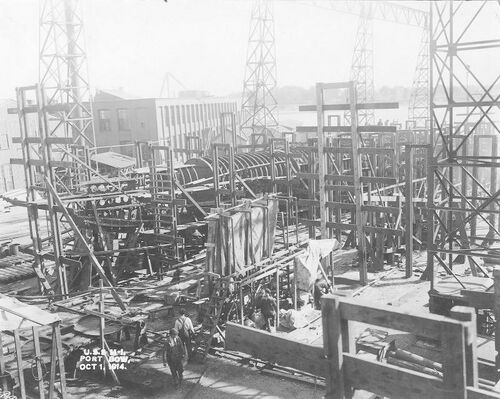
Photo courtesy of the Submarine Force Library & Museum.
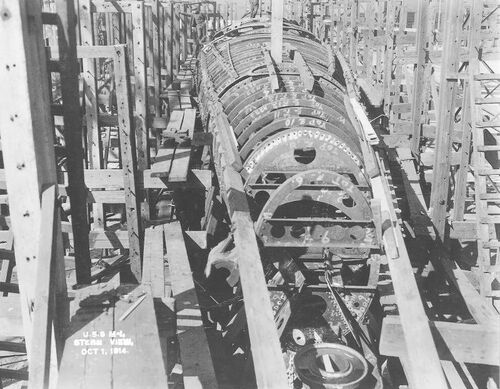
Photo courtesy of the Submarine Force Library & Museum.
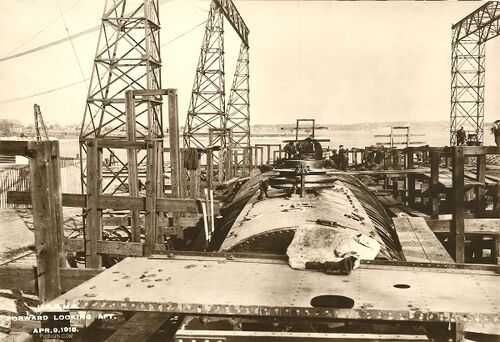
Photo courtesy of the Submarine Force Library & Museum.
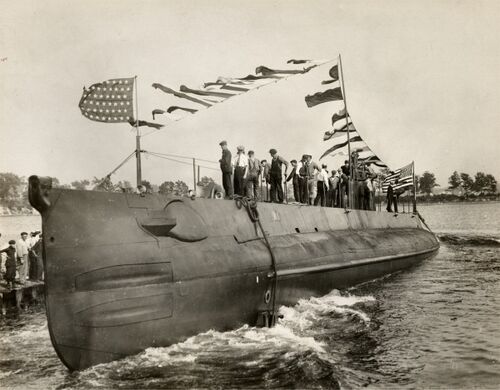
Photo courtesy of the Submarine Force Library & Museum.
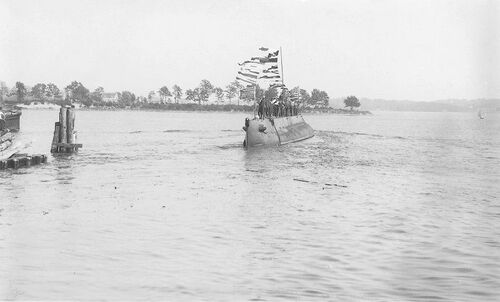
Photo courtesy of the Submarine Force Library & Museum.

National Archives Photo
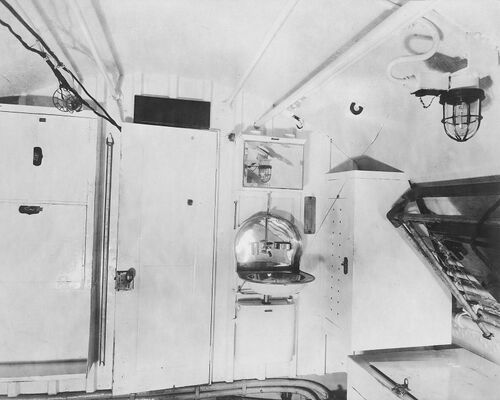
The M-1's officer quarters, in a small compartment between the torpedo room and the crew's quarters. This view is looking aft. The bunk on the right is lifted up exposing a storage locker underneath. A Pullman-style fold up sink is on the bulkhead. The door leads to the battery compartment.
Photo courtesy of the Submarine Force Library & Museum.
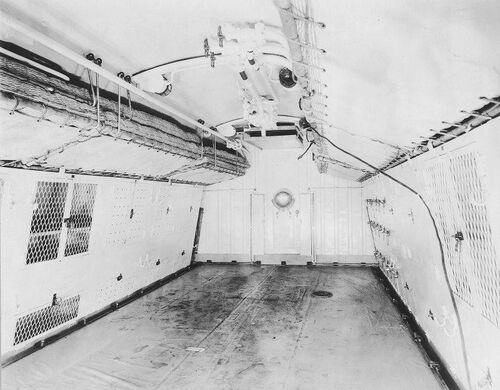
The battery compartment looking forward. The boat's 120 cell battery is located below this deck. Above the deck is the crew's berthing area. The bunks are all triced up to the overhead. Storage lockers are along both sides.
Photo courtesy of the Submarine Force Library & Museum.
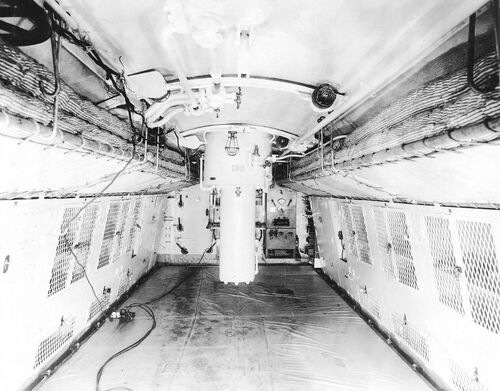
The battery compartment looking aft. The large tub hanging down from the overhead is the tub for the retracted 3"/23 caliber gun. Meters for monitoring the electrical charge in the battery are on the aft bulkhead. The door on the left leads to the control room.
Photo courtesy of the Submarine Force Library & Museum.
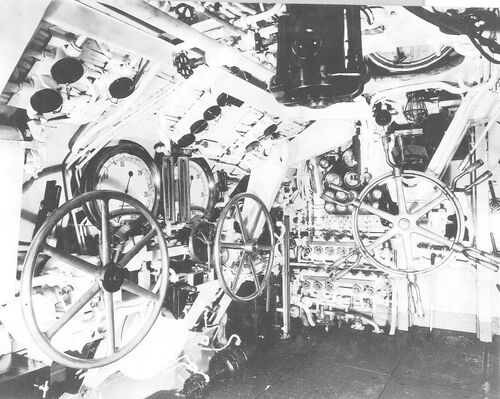
The control room of M-1, looking forward and to port. The wheel on the forward bulkhead is the helm. The large handles are for when it has to be put into hand power mode. The bow and stern diving planes wheels are on the left with the depth gauges in between. Air manifolds for ballast control are between the helm and the bow planes wheel. The eyepiece for the periscope is in the overhead. The periscope did not retract.
Photo courtesy of the Submarine Force Library & Museum.
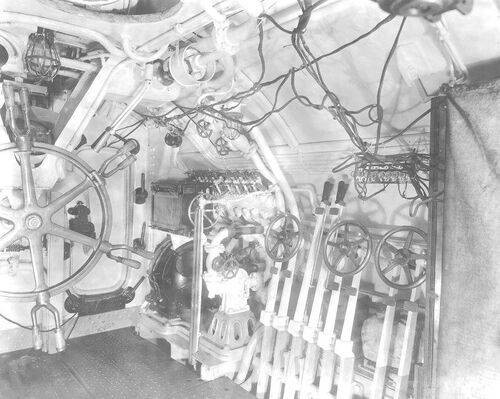
The M-1 control room looking forward and to starboard. In the left center is the trim pump used for pumping ballast water to various tanks, along with the valve manifold for the trim system. To the right are the levers for the Kingston valves that close off the bottom of the ballast tanks. The door next to the helm goes forward into the battery compartment.
Photo courtesy of the Submarine Force Library & Museum.
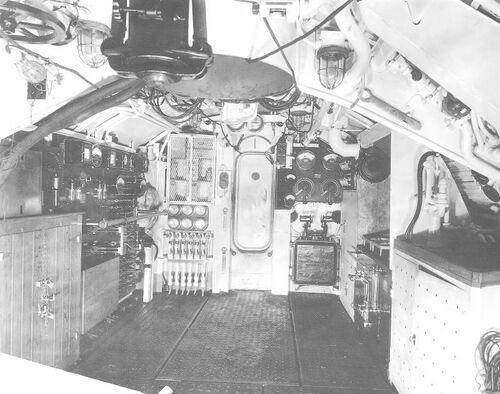
This is the control room looking aft. The periscope eyepiece is in the foreground in the overhead. On the right is the scullery for dishes, followed by the galley equipment. Against the back bulkhead are electrical controls for controlling speed. The watertight door leads to the engine room. To the left of the door on the starboard side are electrical controls and knife switches for lining up the battery for charging or operation.
Photo courtesy of the Submarine Force Library & Museum.
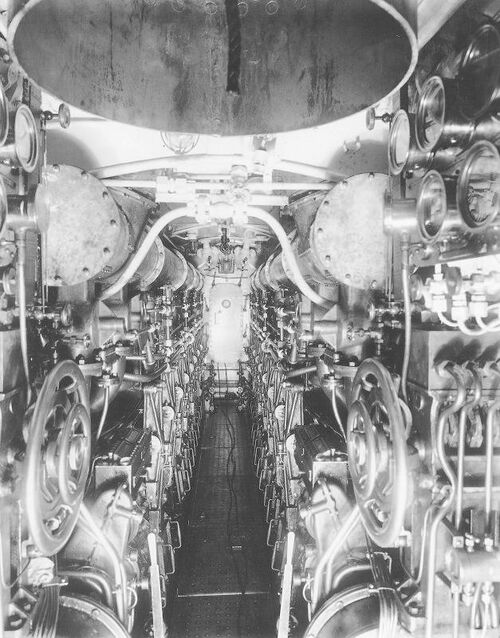
Stepping through the aft door in the control room you would be presented with this sight. This is the engine room looking aft. These two engines are NELSECO 70/6MS diesels. Directly above is an access hatch to the main deck topside. The two large pipes at the top of each engine is the air intake piping for the engines. The door in the background leads to the motor room.
Photo courtesy of the Submarine Force Library & Museum.
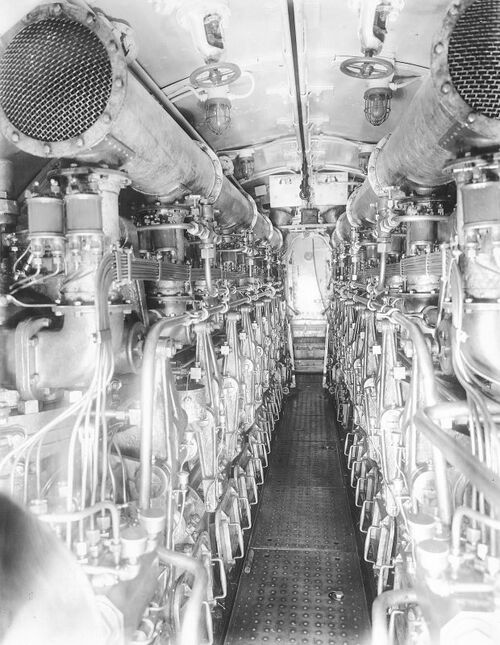
This is the engine room looking forward from the aft end. The valve rocker arms for each engine are exposed along the passage way. An inattentive move by a Motor Machinist Mate could result in a nasty injury from one of the constantly moving rocker arms.
Photo courtesy of the Submarine Force Library & Museum.

The last compartment is the motor room. This compartment has two very large Electro Dynamic propulsion motors that drive the sub when it is submerged, using electricity from the batteries. The motors double as generators when the engines are running. In that mode they are used to recharge the batteries.
Photo courtesy of the Submarine Force Library & Museum.
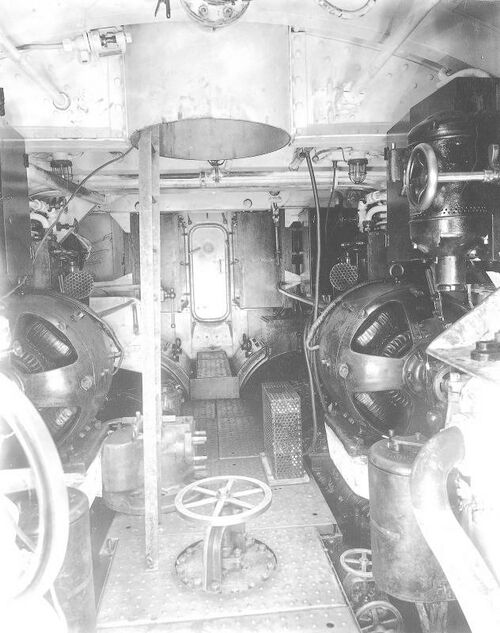
This is as far aft as you can go in the M-1. This view is in the motor room looking forward. There is an access ladder and hatch leading to the main deck. The door in the background leads back into the engine room. Both of the main motors can be seen here. The open casings were needed to keep them cool, but they presented a liability if even a small amount of moisture got into them.
Photo courtesy of the Submarine Force Library & Museum.
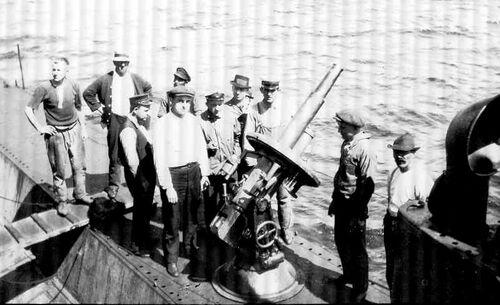
This view is topside and shows the 3"/23 caliber Mk 9 gun in the raised position. The round shield doubled as the top of the watertight tub when the gun was retracted. As you can see, there was little room on deck to operate the gun. There seems to be a mix of Navy and civilian men on deck, indicating that this photo was taken around the time of the M-1's completion, February 1918.
Photo courtesy of Bill Lightfoot, author of Beneath the Surface.
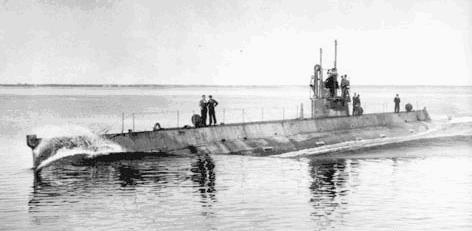
M-1 running at high speed on the surface, likely during trials on the measured mile off Provincetown, MA. in Cape Cod Bay, late 1917 or early 1918. A bridge of any kind has yet to be installed.
Photo in the private collection of Ric Hedman.
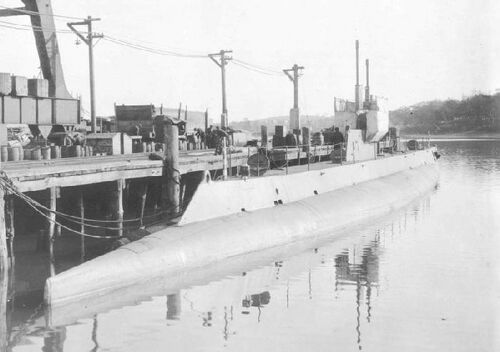
A clean and tidy M-1 pierside, likely at her base at Newport, R.I., 1918. There is some doubt about the date of this photo, with some indications that it was taken in 1915, although the webmasters believe that date doubtful.
Photo in the private collection of Ric Hedman.
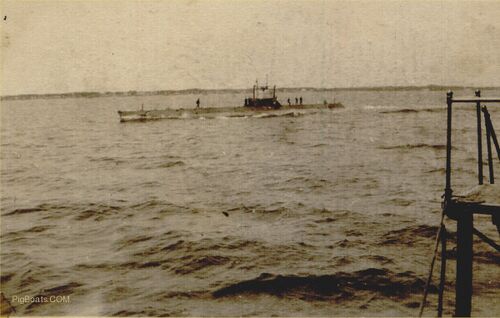
M-1 underway again in what appears to be Cape Cod waters, 1918-1919. Engine tests were frequent, and the measured mile gave the Navy a calibrated range on which precise measurements could be obtained. The photo comes from the scrapbook of Commander James Joseph Hughes, who may have taken the photo. He served on a number of submarines and several administrative staffs. He commanded the USS R-18 when he was a Lieutenant.
Photo in the private collection of Ric Hedman.
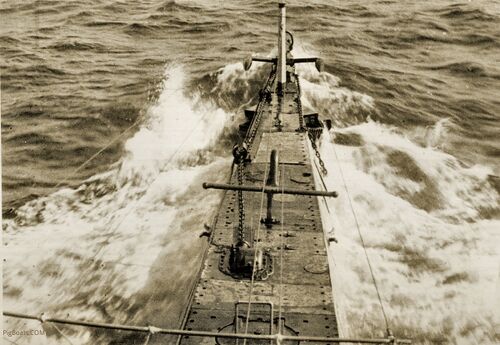
The bow of the M-1 pushes through the waves in a view taken from the bridge, date is approximately 1918-1920. The torpedo loading hatch is seen in the foreground. Just forward of that is the hawsepipe for the anchor windlass, which is directly below the main deck. A towing/anchor chain can be seen running forward along the port side. Just forward of the windlass housing is the T-shaped SC sonar head, and forward of that is a large solid steel padeye used for towing. Near to the tip of the bow is the forward radio aerial mast, which hides one of the three "rats" (transducer heads) for the Y-tube passive sonar system.
Photo in the private collection of Ric Hedman.
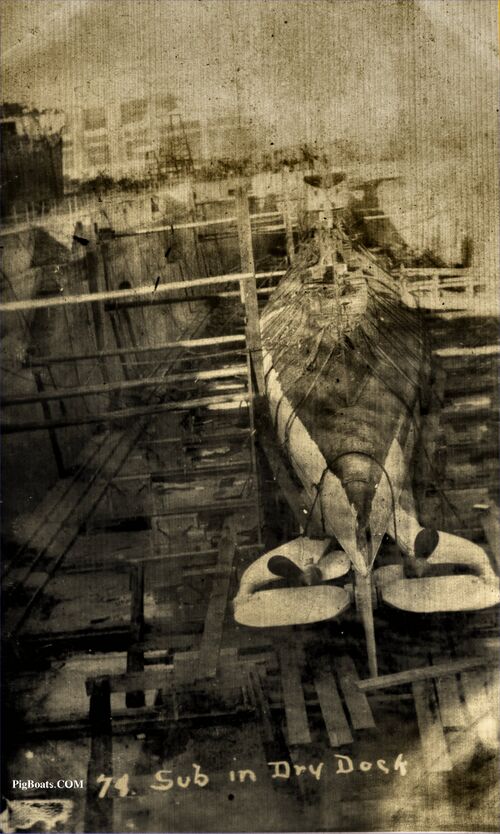
M-1 in drydock viewed from the stern. We actually know very little about this photo, as the original print was not in good condition, but we can make some educated speculation. This is likely near the end of her short career, in early 1922. The location could be Norfolk, VA. or Philadelphia, PA. We are leaning towards Philadelphia. This view gives a good view of her stern diving planes, rudder, and propeller arrangement, along with the sharp vertical "chisel" stern.
Photo in the private collection of Ric Hedman.
Page created by:
Ric Hedman & David Johnston
1999 - 2023 - PigBoats.COM©
Mountlake Terrace, WA, Norfolk, VA
webmaster at pigboats dot com
